Grevillea arenaria
Grevillea arenaria , commonly known as sand grevillea[2] or hoary grevillea,[3] is a species of flowering plant in the family Proteaceae and is endemic to New South Wales. It is a spreading shrub with elliptic to egg-shaped leaves with the narrower end towards the base, and red, pink or orange flowers.
| Grevillea arenaria | |
|---|---|
 | |
| Scientific classification | |
| Kingdom: | Plantae |
| Clade: | Tracheophytes |
| Clade: | Angiosperms |
| Clade: | Eudicots |
| Order: | Proteales |
| Family: | Proteaceae |
| Genus: | Grevillea |
| Species: | G. arenaria |
| Binomial name | |
| Grevillea arenaria | |
| Synonyms[1] | |
|
Embothrium arenarium (R.Br.) Dum.Cours. | |
Description
Grevillea arenaria is an erect to spreading shrub that grows to a height of 0.3–4 m (1 ft 0 in – 13 ft 1 in). The leaves are elliptic to egg-shaped with the narrower end towards the base, 15–75 mm (0.59–2.95 in) long and 3–15 mm (0.12–0.59 in) wide with the edges turned down or rolled under. The flowers are arranged in groups of two to six on the ends of short side branches along a rachis 1–10 mm (0.039–0.394 in) long, and are red, pink or orange and hairy. The pistil is 24–32 mm (0.94–1.26 in) long and the ovary is sessile. Flowers are present in most months with a peak in spring.[4][5]
Taxonomy
Grevillea arenaria was first formally described in 1810 by Robert Brown in Transactions of the Linnean Society of London from specimens collected near Port Jackson.[6][7]
The names of two subspecies are accepted by the Australian Plant Census:
- Greville arenaria R.Br. subsp. arenaria,[8] commonly known as sand grevillea has leaves that are silky- or woolly-hairy on the lower surface and a gynoecium 22–27 mm (0.87–1.06 in) long;[2][4][9]
- Grevillea arenaria subsp. canescens (R.Br.) Olde & Marriott[10] commonly known as hoary grevillea has leaves that are velvety on the lower surface and a gynoecium 26–32 mm (1.0–1.3 in) long;[3][4][11]
Distribution and habitat
This grevillea grows in open forest, often in rocky places, near creeks or cliffs in south-eastern New South Wales. Subspecies arenaria mostly occurs on the eastern side of the Great Dividing Range and nearby ranges from Richmond to the Deua River and subspecies canescens is mostly found on the drier, western side of the ranges, from Tamworth and Gilgandra to Bathurst and western parts of the Blue Mountains.[4][9][11]
References
- "Grevillea arenaria". Australian Plant Census. Retrieved 27 November 2021.
- Makinson, Robert O. "Grevillea arenaria subsp. arenaria". Royal Botanic Garden Sydney. Retrieved 27 November 2021.
- Makinson, Robert O. "Grevillea arenaria subsp. canescens". Royal Botanic Garden Sydney. Retrieved 27 November 2021.
- Makinson, Robert O. "Grevillea arenaria". Royal Botanic Garden Sydney. Retrieved 27 November 2021.
- "Grevillea arenaria". Australian Biological Resources Study, Department of Agriculture, Water and the Environment: Canberra. Retrieved 27 November 2021.
- "Grevillea arenaria". APNI. Retrieved 27 November 2020.
- Brown, Robert (1810). "On the Proteaceae of Jussieu". Transactions of the Linnean Society of London. 10 (1): 172. Retrieved 27 November 2021.
- "Grevillea arenaria subsp. arenaria". Australian Plant Census. Retrieved 27 November 2021.
- "Grevillea arenaria subsp. arenaria". Australian Biological Resources Study, Department of Agriculture, Water and the Environment: Canberra. Retrieved 27 November 2021.
- "Grevillea arenaria subsp. canescens". Australian Plant Census. Retrieved 27 November 2021.
- "Grevillea arenaria subsp. canescens". Australian Biological Resources Study, Department of Agriculture, Water and the Environment: Canberra. Retrieved 27 November 2021.